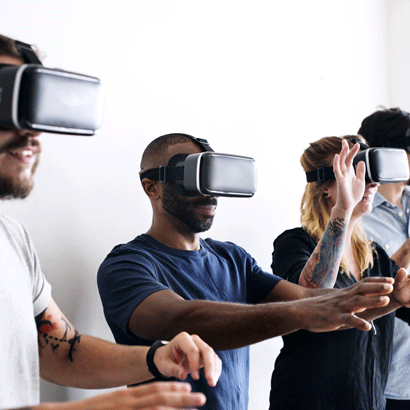
Park and recreation agencies aim to offer a variety of programs and services that benefit their community members. From providing local gathering spaces to organizing young adult sports leagues, professionals in this field are passionate about seeking new and impactful ways to engage their community.
Looking to take your parks and recreation professional development opportunities to the next level? Try incorporating the latest cutting-edge technology — namely, virtual reality (VR)!
VR can revolutionize how you bring community members together and provide value to their lives. If you’re new to this evolving technology, don’t worry! Below, we’ll introduce you to it and the potential benefits of incorporating it into your parks and recreation agency. We’ll also offer four ways you can leverage VR to upgrade your professional development programs and virtual event management.
What Is Virtual Reality?
Virtual reality is a technology that builds simulated environments for people to enter and experience. There are different levels of virtual reality:
- Non-immersive VR: This experience is similar to a video game. A user remains aware of and controlled by their physical environment, but travels through a computer-generated story or activity on a screen.
- Semi-immersive VR: Here, users partially remain in their physical environment, but experience a simulation through projected computer graphics and other features that let them feel the virtual scenario. A flight simulation is a good example, where pilot trainees move through a flight pattern while never actually leaving the ground.
- Fully immersive VR: This technology doesn’t exist yet, but may in the near future. The experience would fully place an individual in their simulated environment, allowing them to feel all five senses through the technology.
To use virtual reality, organizations need specific tools, such as head-mounted displays that allow users to be visually immersed in the simulation.
What Are Some Benefits of Using Virtual Reality?
Knowing how VR fits into your overall mission helps build the case for investing in this innovative technology.
Park and recreation agencies can experience a variety of benefits from leveraging virtual reality for professional development and other engagement opportunities, such as:
- Increased engagement: Virtual reality is more interactive, entertaining and capable of retaining interest for longer periods of time than more traditional training models.
- Broader reach: VR isn’t constrained to a physical space. This means parks and recreation agencies can invite experts and speakers from outside the local area to engage with their community members in virtual reality.
- Reduced environmental footprint: Given the reduced need for physical travel, VR allows people to attend events and activities without impacting natural resources. It’s a great way to keep your agency carbon conscious.
Your community members will appreciate the innovative experiences that you offer them through virtual reality as well.
4 Ways to Leverage Virtual Reality for Professional Development
So, you now know the basics of what VR is and how it can be beneficial, but how do you actually put it to use? Here are four ideas to get you started!
1. Host a Conference in Virtual Reality
By this point, people have gotten used to meeting through video conferencing software. However, these meetings can be challenging for keeping people engaged, especially in larger events like conferences. Incorporating VR into a virtual conference can increase participant interactions and overall attendee enjoyment.
By wearing a VR headset, members can enter a simulated conference room and interact with one another. You can even change locations if you want to tailor your conference topics to specific parks, team sports or other activities your parks and recreation professionals encounter through their work. Even members without headsets can participate by watching the simulation.
2. Create a Virtual Reality Networking Community
Virtual reality can bridge geographic distances by creating a virtual reality networking community where people can meet and share knowledge with others outside of their local area. These informal connections can improve their professional success.
To leverage VR in this way, simply invite members to gather in a simulated environment that facilitates community and communication. Networking events can take the form of happy hours or speed networking in small groups.
3. Provide Engaging Virtual Reality Mentorship Experiences
Virtual reality mentorship is a great way to support youth and young adults in the community. This demographic is already more familiar with these technological advances and may be more interested in learning how to leverage them to advance their growth.
There are other less formal ways to use virtual reality for mentorship as well. Consider incorporating fitness classes or well-being activities, such as yoga or meditation, to connect with community members.
4. Offer Professional Training and Certifications in Virtual Reality
Since you can bring your classroom to your participants, VR opens so many possibilities for training and certifications. You can provide more immersive and interactive learning experiences as well as simulate virtual field trips that transport members into specific locations or situations for the best training possible.
For example, you can host job interviewing workshops that help professionals prepare for advancement opportunities in their field. Learning management software can help you keep track of the resources and materials you provide in training sessions and workshops. You can also leverage it to link members to their certifications once earned.
Connect With Your Community Through Diverse Uses of VR
Technological advances occur quickly and can be applied to a variety of fields. Virtual reality is an innovative technology that can empower parks and recreation agencies to create enriching experiences for their community members. This leads to a more tight-knit and engaged community as a whole.
Sonia Urlando is the Content Marketing Manager at Personify for the WildApricot and MemberClicks brands.

